Abstract
Rebaudioside E, one of the minor components of steviol glycosides, was first isolated and identified from Stevia rebaudiana in 1977. It is a high-intensity sweetener that tastes about 150–200 times sweeter than sucrose and is also a precursor for biosynthesis of rebaudioside D and rebaudioside M, the next-generation Stevia sweeteners. In this work, new unknown steviol glycosides were enzymatically synthesized from stevioside by coupling UDP-glucosyltransferase UGTSL2 from Solanum lycopersicum and sucrose synthase StSUS1 from Solanum tuberosum. Rebaudioside E was speculated to be the main product of glucosylation of the Glc(β1→C-19) residue of stevioside along with the formation of a (β1→2) linkage based on the analysis of the regioselectivity and stereoselectivity of UGTSL2, and verified afterwards by LC-MS/MS with standard. In a 20-ml bioconversion reaction of 20 g/l stevioside by UGTSL2 and StSUS1, 15.92 g/l rebaudioside E was produced for 24 h.





Similar content being viewed by others

References
Tasso, I. S., Santos, T. G., & Seibel, N. F. (2019). Elaboration of a natural sweetener using erythritol/stevia. Food Sci Technol Campinas, Online ahead of Print, 40(2), 370–375. https://doi.org/10.1590/fst.42718.
Olsson, K., Carlsen, S., Semmler, A., Simon, E., Mikkelsen, M. D., & Moller, B. L. (2016). Microbial production of next-generation stevia sweeteners. Microbial Cell Factories, 15(1), 207–220.
Goyal, S. K., & Samsher, & Goyal, R. K. (2010). Stevia (Stevia rebaudiana) a bio-sweetener: a review. International Journal of Food Sciences and Nutrition, 61(1), 1–10.
Roberto, L. M., Antonio, V. G., Liliana, Z. B., & Kong, A. H. (2012). Stevia rebaudiana Bertoni, source of a high-potency natural sweetener: a comprehensive review on the biochemical, nutritional and functional aspects. Food Chemistry, 132, 1121–1132.
Tao, R., & Cho, S. (2020). Consumer-based sensory characterization of steviol glycosides (rebaudioside A, D, and M). Foods, 9(8), 1026–1040.
Prakash, I., Bunders, C., Devkota, K. P., Charan, R. D., Ramirez, C., Snyder, T. M., et al. (2014). Bioconversion of rebaudioside I from rebaudioside A. Molecules, 19(11), 17345–17355.
Wang, Y., Chen, L. L., Li, Y., Li, Y. Y., Yan, M., Chen, K. Q., et al. (2016). Efficient enzymatic production of rebaudioside A from stevioside. Bioscience, Biotechnology, and Biochemistry, 80(1), 67–73.
Li, Y., Li, Y. Y., Wang, Y., Chen, L. L., Yan, M., Chen, K. Q., et al. (2016). Production of rebaudioside A from stevioside catalyzed by the engineered Saccharomyces cerevisiae. Applied Biochemistry and Biotechnology, 178(8), 1586–1598.
Chen, L. L., Sun, P., Zhou, F. F., Li, Y., Chen, K. Q., Jia, H. H., et al. (2018). Synthesis of rebaudioside D, using glycosyltransferase UGTSL2 and in situ UDP-glucose regeneration. Food Chemistry, 259, 286–291.
Bursać Kovačević, D., Maras, M., Barba, F. J., Granato, D., Roohinejad, S., Mallikarjunan, K., Montesano, D., Lorenzo, J. M., & Putnik, P. (2018). Innovative technologies for the recovery of phytochemicals from Stevia rebaudiana Bertoni leaves: a review. Food Chemistry, 268, 513–521.
Dong, J. P., & Yang, Z. (2019). Characterization of a new hemihydrate rebaudioside B crystal having lower aqueous solubility. Food Chem, 304, Article 125444. DOI: https://doi.org/10.1016/j.foodchem.2019.125444.
Sakai, S., & Shinma, N. (1977). Application of 13C-NMR spectroscopy to chemistry of natural glycosides: rebaudioside-C, a new sweet diterpene glycosides of Stevia rebaudiana. Chemical & Pharmaceutical Bulletin, 25, 844–846.
Sakamoto, I., Yamasaki, K., & Tanaka, O. (1977). Application of 13C-NMR spectroscopy to chemistry of plant glycosides: rebaudioside-D and -E, new sweet diterpene-glucosides of Stevia rebaudiana Bertoni. Chemical & Pharmaceutical Bulletin, 25(12), 3437–3439.
Ohta, M., Sasa, S., Inoue, A., Tamai, T., Fujita, I., Morita, K., & Matsuura, F. (2010). Characterization of novel steviol glycosides from leaves of Stevia rebaudiana Morita. Journal of Applied Glycoscience, 57(3), 199–209.
Prakash, I., Bunders, C., Devkota, K. P., Charan, R. D., Ramirez, C., Parikh, M., & Markosyan, A. (2014). Isolation and structure elucidation of rebaudioside D2 from bioconversion reaction of rebaudioside A to rebaudioside D. Natural Product Communications, 9(8), 1135–1138.
Starratt, A. N., Kirby, C. W., Pocs, R., & Brandle, J. E. (2002). Rebaudioside F, a diterpene glycoside from Stevia rebaudiana. Phytochemistry, 59(4), 367–370.
Prakash, I., Chaturvedula, V. S. P., & Markosyan, A. (2013). Isolation, characterization and sensory evaluation of a hexa beta-D-glucopyranosyl diterpene from Stevia rebaudiana. Natural Product Communications, 8, 1523–1526.
Prakash, I., Bunders, C., Devkota, K. P., Charan, R. D., Ramirez, C., Priedemann, C., et al. (2014). Isolation and characterization of a novel rebaudioside M isomer from a bioconversion reaction of rebaudioside A and NMR comparison studies of rebaudioside M isolated from Stevia rebaudiana Bertoni and Stevia rebaudiana Morita. Biomolecules, 4(2), 374–389.
Perera, W. H., Ghiviriga, I., Rodenburg, D. L., Alves, K., Bowling, J. J., Avula, B., Khan, I. A., & McChesney, J. D. (2017). Rebaudiosides T and U, minor C-19 xylopyranosyl and arabinopyranosyl steviol glycoside derivatives from Stevia rebaudiana (Bertoni) Bertoni. Phytochemistry, 135, 106–114.
Chatsudthipong, V., & Muanprasat, C. (2009). Stevioside and related compounds: therapeutic benefits beyond sweetness. Pharmacology & Therapeutics, 121(1), 41–54.
Weng, J. Y., Chen, L. L., Cheng, Y. C., Li, Y., Jia, H. H., Zhou, H., et al. (2019). Expression, characterization, and site-directed mutagenesis of UDP-glycosyltransferase UGT88A1 from Arabidopsis thaliana. Bioengineered, 10(1), 142–149.
Bradford, M. M. (1976). A rapid and sensitive method for the quantitation of microgram quantities utilizing the principle of protein-dye binding. Analytical Biochemistry, 72(1-2), 248–254.
Chen, L. L., Sun, P., Li, Y., Yan, M., Xu, L., Chen, K. Q., et al. (2017). A fusion protein strategy for soluble expression of Stevia glycosyltransferase UGT76G1 in Escherichia coli. 3 Biotech, 7, Article 356. DOI: https://doi.org/10.1007/s13205-017-0943-y.
Miller, G. L. (1959). Use of dinitrosalicylic acid reagent for determination of reducing sugar. Analytical Chemistry, 31(3), 426–428.
Li, J., Chen, Z. B., & Di, D. L. (2012). Preparative separation and purification of rebaudioside A from Stevia rebaudiana Bertoni crude extracts by mixed bed of macroporous adsorption resins. Food Chemistry, 132(1), 268–276.
Molina-Calle, M., Priego-Capote, F., & Luque de Castro, M. D. (2017). Characterization of Stevia leaves by LC–QTOF MS/MS analysis of polar and non-polar extracts. Food Chemistry, 219, 329–338.
Sun, Y. W., Chen, Z., Li, J. X., Li, J. H., Lv, H. J., Yang, J. Y., et al. (2018). Diterpenoid UDP-glycosyltransferases from Chinese sweet tea and ashitaba complete the biosynthesis of rubusoside. Molecular Plant, 11(10), 1308–1311.
Funding
This study was financially supported by the NSFC-China (21878155), Provincial Key R&D Plan of Jiangsu-China (BE2017703), PAPD-China, Qing Lan Project of Jiangsu Universities-China, Six Talent Peaks Project in Jiangsu Province-China, and Jiangsu Synergetic Innovation Center for Advanced Bio-Manufacture-China.
Author information
Authors and Affiliations
Contributions
LC and YL conceived and designed the study. LC, HP, and RC performed the experiments and analyzed the data. LC wrote the paper. HJ, KC, MY, and PO reviewed and edited the manuscript. All authors read and approved the manuscript.
Corresponding author
Ethics declarations
Conflict of Interest
The authors declare that they have no competing interests.
Additional information
Publisher’s Note
Springer Nature remains neutral with regard to jurisdictional claims in published maps and institutional affiliations.
Electronic Supplementary Material
ESM 1
(DOCX 516 kb)
Rights and permissions
About this article
Cite this article
Chen, L., Pan, H., Cai, R. et al. Bioconversion of Stevioside to Rebaudioside E Using Glycosyltransferase UGTSL2. Appl Biochem Biotechnol 193, 637–649 (2021). https://doi.org/10.1007/s12010-020-03439-y
Received:
Accepted:
Published:
Issue Date:
DOI: https://doi.org/10.1007/s12010-020-03439-y



